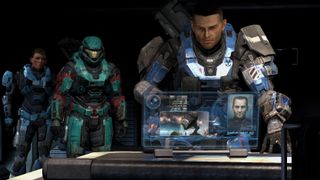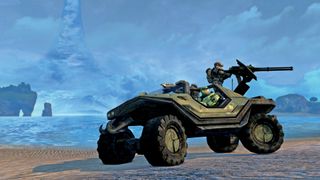The Halo campaigns, ranked from worst to best
Our favorite Halo campaigns, from Combat Evolved to Infinite.

PC Gamer Ranked are our ridiculously comprehensive lists of the best, worst, and everything in-between from every corner of PC gaming.
Halo is no longer bound by numbers, but that hasn't stopped us from counting them up and ranking them. With Halo Infinite there are now eight campaigns, and the arrival of the first open-world Halo made us reconsider our favorite and least favorite Spartan adventures.
The Halo completionists on our team voted on the best campaigns across the series. We decided to talk about the campaigns alone here, because while weighing multiplayer at the same time made it too hard to call, we have strong opinions on what makes for a great set of FPS missions. Still, we were in for some surprise debates as we started writing about each game in the series, like:
- Is the Warthog Halo's greatest strength or an affront to god?
- Did we do Halo 3: ODST dirty?
- Did Morgan sell his votes for a Game Fuel sponsorship?
Until the next Halo campaign arrives, here's our ranking of every game in the series, ordered from worst to best.
The Criteria
Number of entries: Eight.
What's included: Every FPS Halo campaign.
What's not included: Extra modes like Firefight and Halo 4's Spartan Ops, as well as the spin-off Halo Wars RTS games or the two mobile games. We also didn't include the arcade-exclusive Fireteam Raven, though it is technically a first-person shooter.
The biggest gaming news, reviews and hardware deals
Keep up to date with the most important stories and the best deals, as picked by the PC Gamer team.

8. Halo 4

Wes Fenlon, Senior Editor: I recall the moment Halo 4 trotted out a QTE in its first level, and the sad little "oh, no" I felt right then. Mercifully, it was one of only two or three QTEs in the whole campaign, and despite ranking last on this list, Halo 4 really isn't a bad game. But it's Halo at its most generic.
Halo 4's campaign has a few blatant issues. The story relies on Halo's expanded universe lore for the first time, and if you played through it without seeking out in-game datapads or reading a couple novels, you'd likely have no damn idea what was going on. Missions are noticeably more linear than any of Bungie's Halo campaigns, missing that expressive play and unpredictability that makes Halo's combat really come alive. And most damning, the new enemies, the Prometheans, just... aren't fun to shoot. They lack the reactivity of the Covenant enemies, and there's always a "best" order to attack them in, making fights feel samey and repetitive for the first time in Halo history.
On the positive side, Halo 4's environments look fantastic for an Xbox 360 game, and I remember especially liking the towering Forerunner architecture. Just wish it'd been in a game I actually enjoyed playing.
Morgan Park, Staff Writer: Those Promethean guns really did suck the fun out of otherwise okay fights. What a total misfire.
Nat Clayton, Features Producer: They ruined the Warthog, guys. I made it through the game's first level with a few concerns, but the moment I got behind the wheel of 343's wimpy, toy-like excuse for a jeep, I knew I was out.
7. Halo 5: Guardians

Wes: These two were actually tied for last in our voting, but I say Halo 5 wins the "at least they tried" award for gamely tackling Halo 4's weaknesses—then failing in its own ways. The developers really tried to make the Prometheans more fun to fight, making Knights less bullet-spongey and stopping them from teleport-zipping around the map. Even so, something about them's off, and their aggressively cyborg-y sci-fi aesthetic never really feels right, either. Halo 5 also tried to fix 4's linear levels by adding alternating paths around maps, a welcome change that again didn't quite land. These largely came in the form of walls you could bust down with a new thruster charge attack, and they're comically artificial in the more natural environments.
Halo 5 tries to tell a story that doesn't require a lore deep dive by sending a new squad of Spartans off to stop Master Chief from palling around with Cortana, but the showdown comes off as incredibly contrived. A lot of the Halo stories probably land firmly in "didn't really care" territory for most players, but Halo 5's is actively and damn-near universally disliked. By the time this game repeats the same terrible boss fight for the third time, I was done with it, but I do think it was a savvy move to design the Spartan squads around the co-op experience.
And yes, because I'm that nerd who read The Fall of Reach, seeing OG Spartan IIs Kelly, Linda, and Fred show up in a game did make me briefly happy.

Halo 5 wins the "at least they tried" award for gamely tackling Halo 4's weaknesses
Morgan: I still think Halo 5 was one of the strongest multiplayer shooters on consoles back in 2015. It keps some of Halo 4's best qualities, added fun new Spartan abilities, and had an especially satisfying pistol. The problem is those things all live in a campaign that isn't much fun otherwise. 343 also added reviving to co-op, which killed that fun scramble where a surviving teammate searches for a safe corner to let you respawn.
Wes: It's still not on PC, by the way, but I have a hard time believing it won't become part of the Master Chief Collection someday.
6. Halo 3: ODST

Nat: Sincerely, what the fuck at sixth place. Halo 3 ODST might not be the biggest, best, or most "Halo" Halo, but for my money, it's the most memorable Halo—an experimental tone piece that turns Halo 3's sci-fi antics into a moody jazz EP.
Long before Halo Infinite, ODST experimented with turning Halo into a tightly controlled open world, stranding you in the jazz-soaked streets of New Mombasa as an Orbital Drop Shock Trooper—elite soldiers who hurl themselves into battle by dropping out of spaceships in big metal bins. You're good, but you're not Master Chief, and skulking through nighttime streets has a real tension as you dodge patrols of Covenant invaders.
ODST's New Mombasa has so much more character than Infinite's pine forests, driven largely by the city's Superintendent AI. Feeling lost? Look around, and you'll see billboards and street signs flash with directions to secrets and objectives. More traditional Halo missions play out in flashbacks as you find evidence of your squadmates (voiced, for better and worse, by the cast of Firefly). Somehow, ODST manages to pull more visual and thematic variety out of one Earth city than Infinite can wring out of an entire ringworld, going from vertigo-inducing skyscraper brawls to a Warthog romp across a safari park.
But ODST is at its best when you take time to soak in the city streets, turning off your night-vision and picking up logs that tell a surprisingly thrilling noir side story. If someone asked me what entry best defined Halo, it wouldn't be ODST. But if you're looking for the bravest, strangest punch Bungie ever pulled with the series, well... get set for drop.

If you're looking for the bravest, strangest punch Bungie ever pulled with the series, well... get set for drop.
Wes: Did Mombassa's streets really have such variety? I don't remember having that much to do in them but walk from one mission trigger to the next and fight some small patrols on the way. But that also doesn't really matter to me, because the streets are just there for vibes. And boy, the vibes are goooood. That soundtrack! The actual missions are all snacky fun, too, and Bungie was clearly liberated by crafting vignette action scenes without worrying about them all being strung together. The cool jazz and popcorn chicken Halo.
Morgan: I've read a lot of interesting takes on ODST's distinct tone over the years and haven't really connected with them. I like the format of the campaign and appreciate that Bungie went full Bioshock with audio logs, but I think it's a weaker-playing Halo. I ended up connecting way more with the characters of Reach!
5. Halo Reach

Wes: My memories of Reach were long tangled up in the changes Bungie made to its multiplayer, with awkward implementation of loadouts and sprint, and the maligned armor abilities like Armor Lock. When I revisited it for a review of the PC version in 2019, I realized just how good Reach's campaign really is. It's lean but substantial, no fat, no levels that go on forever while you explore identical Forerunner hallways. It delivers several of the great, sprawling setpiece levels I crave from a Halo campaign, with open-ended spaces to explore in vehicles or on foot. I especially love the mission where you're helping evacuate the doomed human city of New Alexandria as it's overrun by the invading Covenant, fighting through offices, jetpacking across buildings, manning the turret on a flying troop transport, and finally driving your Warthog to assault an island of dug-in aliens. It's got everything.
Easily the most confident and consistent Halo campaign of them all.
You can really feel Bungie flexing its storytelling muscles here after getting tired of Master Chief's solo adventures, and I appreciate the snippets of camaraderie we get from Reach's doomed Spartan squad. Their sacrificial moments avoid veering too far into melodrama—it's really a surprisingly subdued game, considering it's about a bunch of supersoldiers fighting a doomed battle to save a whole planet. The fantastic ending really drives home that somber tone. It's easily the most confident and consistent Halo campaign of them all.
Nat: I loved Halo Reach at the time, and I still think it's a great game. But with each passing year, it feels like the turning point for where Halo goes wrong: a muddier, fussier art style, a new emphasis on Spartans beyond Master Chief, and increased exposition for a series that is best treated with vague grandeur. Reach finds a balance, but it's so easy to see where 343 took the elements it laid down and ran them into the ground.
As a tone piece, however, Reach is impeccable. It's a wonderfully tragic final note for Bungie before the developer handed off the series to new hands.
4. Halo Infinite

Jody Macgregor, AU/Weekend Editor: Halo Infinite is the back-to-basics campaign, putting the Chief and an AI on a ring to zap aliens like the old days. The Banished may be The Covenant we've got at home, but that's fine—their budget Grunts have the best barks yet. When one ran from me, arms in the air, another stood its ground and declared, "I'll never run! I'm too lazy!"
Halo started as a quippy action movie with the occasional bit of space grandeur, and Infinite is the same. It's funny, fast-paced, and only sparingly cranks up the score while something explodes or hangs there, being dramatic and mysterious.
In some ways, Infinite feels like what Combat Evolved would have been with a bigger budget and more time. Its "wide corridor" open world is a scaled-up version of the first game's biggest levels, perfect for joyriding with a gang of unruly marines. The most significant new addition, the grappling hook, makes barreling across that world into a good time even when you don't have a vehicle. See that mountain? You can yank yourself up it, then fling yourself over the top, safe in the knowledge there's no fall damage and you'll probably land in the middle of a firefight on the other side.

Morgan: This one's too high for me, acknowledging I haven't finished Infinite's campaign yet because I keep getting a tad bored. As Nat noted in her review, I don't think the open world is used very well. Wandering the rolling hills of a halo ring with no restrictions is neat for a while, but it comes at the expense of "classic Halo" vehicle moments that I didn't realize I hold so dear. On the bright side, Infinite is the most fun that Halo combat has ever been. Too bad it's soured by the whole "no co-op at launch" thing. I'm unreasonably annoyed by that bit. Halo played all alone isn't Halo at all.
In some ways, Infinite feels like what Combat Evolved would have been with a bigger budget and more time.
Wes: I miss the great design touches of Bungie's campaign levels, but I kept surprising myself by finding or creating fun moments out in the open world. It's the first time I've actually preferred playing a Halo game on Normal instead of Heroic, because hyper-aggressive grappling hook play is the only way to live. It really does need that co-op, though.
Nat: The more time passes, the more I think I was too generous in my Infinite review. I've probably played more Halo in the last year than any games journo on Earth, but Infinite commits the crime of leaving me frustratingly indifferent. It's the best Halo has ever felt, wrapped in a tedious open world and a story that's lacking in any of the series' spectacle and (despite 343's best efforts) fails to make me care about any of the characters involved.
Folks have complained that Halo Infinite won't let you replay missions, but let's be honest: Can you name even one mission you'd want to revisit? Outside the open world, Infinite's campaign blends into an indistinct labyrinthe of alien corridors and antechambers, well designed fights that you'll forget about instantly.
Infinite is pointedly nostalgic, and when you're exploring shimmering Forerunner tunnels or whipping a Warthog over grassy plains, that nostalgia even sometimes hits. But it's a reminder that through sheer force of weight and time, Halo can no longer be the strange, enigmatic world it used to be.
The Top 3
3. Halo: Combat Evolved

Tyler Colp, Associate Editor: Halo: Combat Evolved gave us the words to talk about shooters the way we do now. It gave us the corridors, the choral intro, the projectile weapons, the Energy Sword, and the Master Chief. It also gave us a stark, alien world strung together by a riotous soundtrack and an austere art style. Everyone knows Halo because it defined a particular time in culture that’s still felt today.
It didn’t know it at its 2001 release, but Halo was the shooter for non-shooter players. It took the speed of the games before it, slowed it down, stretched it out, and made a playground of action. At the time, shooter combat didn’t pop and hiss like Halo’s funky assortment of weapons and vehicles, and I think they still don’t today. It has its faults. The Library level frustrates many, but when so many modern shooters desperately try to slide you through an experience, it’s nice to have a distinct memory of a thing, regardless of its quality. Halo: Combat Evolved could be described as a lot of things—it’s rudimentary, it’s repetitive, it’s weird, but it’s definitely not forgettable.

Jody: The Warthog Run still sucks, though.
Morgan: Wha... what?
Nat: I will fight you, Jody.
But seriously, Halo has a tense, alien vibe that later games never manage to recapture. This is in part due to technical limitations—plans to have roaming herds of animals were scrapped, and of course Forerunner structures look like that with those polycounts. But that lends the enigmatic ringworld a real sense of the unknown, a quiet place that stood undisturbed for millennia, harbouring grotesque secrets that would have stayed buried had Chief and the gang not crashed a ship into it.
Halo: Combat Evolved gave us the words to talk about shooters the way we do now.
These days, everyone knows what a Forerunner is, who the Flood are, and why there's a series of massive hula-hoops scattered across the galaxy. But Halo CE felt strange and terrifying in a way that I'll never forget. And the Warthog run bangs, actually.
Wes: The simplicity of Halo: CE's story really is one of its great strengths. Knowing so little about its universe is what drew us in. It really could've been an incredible piece of one-off sci-fi if Bungie had never made a sequel. Bungie really had a knack for nailing those moments of wonder: stepping out of a tunnel to find yourself in a snow-covered valley, mentally mapping out the geography of The Silent Cartographer's island, sneaking aboard a Covenant ship in the dark of night.
2. Halo 2

Morgan: I grew up hearing that Halo 2 is the worst of the original trilogy. I played it alongside everyone else in 2004, and as a dumb 8-year-old, all I absorbed at the time was "this Scorpion part on the bridge totally rules." Flash-forward to when I played every Halo campaign last year via the Master Chief Collection and my new takeaway was, "this Scorpion part on the bridge totally rules."
Then I remembered all the other cool stuff that happens in Halo 2. Having active camo at the touch of a button while playing as the Arbiter? Sick. Chief giving the Cuv'nent back their bomb? Iconic. Absurdly powerful rendition of the Battle Rifle? Please and thank you. Dual-wielding Needlers? I'm on it. I'm happy to acknowledge the missteps that Halo 3 corrects, like the tragic loss of the Assault Rifle and the Legendary difficulty mode that's so flippin' hard in co-op it's often an unfun slog. I'd also remind you of the excellent Delta Halo mission that lets players fight through a jungle temple biome with Warthogs, rocket launchers, Scorpions, and sniper rifles. It's followed immediately by that cool part where you snipe Covenant on a moving gondola going both ways.

Halo 2 realised that what Halo needed, more than anything else, was a healthy injection of Keith David.
Nat: Halo 2 Anniversary's remaster learned the right lessons from the somewhat botched remake of the first game. That's important, because the original Halo 2 is a brown smear of a game, evidence of its tortured development cycle. Anniversary, in contrast, is a properly beautiful thing.
Halo 2 isn't my favourite Halo. It's a troubled middle chapter, and it doesn't quite hit the highs of Halo CE, Halo 3, or ODST. But its changes set up a phenomenal gameplay foundation for Halo 3 to build from. Most important of all, Halo 2 realised that what Halo needed, more than anything else, was a healthy injection of Keith David.
Wes: Halo 2 introduced several things that are core Halo DNA to me. It wiped away fall damage, dramatically changing what it felt like to play as a Spartan supersoldier. It gave us the Battle Rifle, instantly becoming the Halo weapon of choice. It added vehicle boarding and the Gauss Warthog, the once and future king of all Halo vehicles. Halo 2 even sped up shield recharging significantly, changing the cadence of battles. The campaign drags in a few spots, but this is the game that set the template for how all future Halo would play. It only took Bungie one more game to get it just right.
1. Halo 3

Wes: Not only does the Warthog Run not suck, Jody, but its reprise in Halo 3 is probably still the most thrilling end to a FPS campaign I've ever played! Halo 3 ends the trilogy with a Warthog race across the exploding ring, theme song roaring gloriously in the background. And when you manage to complete it flawlessly in co-op in a single go... that's peak videogames, right there.
Halo 3 stands as the most inventive and replayable campaign of the series, which is extra impressive considering it has at least one outright stinker of a mission: the infamous Cortana, a trip through a confusing rectum of Flood enemies that stops you every few minutes so a mad AI lady can yell at you. It's even worse than The Library in Halo 1.
But damn, does the best of Halo 3's campaign make up for that weak spot. You've got Tsavo Highway, The Covenant, and The Ark, sweeping open missions that expertly balance vehicle shenanigans with on-foot combat. The Silent Cartographer gets all the name recognition for being the perfect Halo mission, but The Covenant, a clear homage, is an even better journey. Halo 3's battles against the giant Scarab walkers are still a blast because you can take out their legs to board them, or you can hitch a ride with an AI pilot and get dropped on top, or you can launch a Mongoose off a ramp and yeehaw your way on.
Bungie's lighting and art direction hold up phenomenally well on PC 14 years later, and so do bits of Halo 3's writing—basically any words that come out of Keith David's mouth as The Arbiter. I could go on about Halo 3 forever, honestly, but I'll wrap up by reminding you that Halo 3 is responsible for giving us the cheering Grunt Birthday party skull for the first time. What a blessing.

Halo 3 came out and ruled as hard as we all wanted it to.
Morgan: It's impossible to separate my love for Halo 3 the game from Halo 3 the cultural event. My school went absolutely bananas in the weeks leading up to it, and the hype was contagious. I remember huddling around the one kid who had a first-gen iPhone to watch trailers. My dad was bringing Game Fuel home by the 12-pack. Then Halo 3 came out and ruled as hard as we all wanted it to.
Nat: I've wasted away hours replaying that one bit of The Covenant that drops two Scarabs in your face and asks you to figure something out. Halo 3 is Halo perfected, every level offering some brand-new spectacle, featuring a sandbox of weapons, vehicles and (then-new) equipment all interacting in a chaotic, slapstick physics engine. It's still a bloody beautiful game, too. Bungie's skybox artists are at the height of their craft, with matte paintings lending the trilogy-closer an appropriately mythical air.
Halo: What to read next
That's where we stand on every Halo FPS campaign, but do we have more to say about Halo overall? Of course we do.

Wes has been covering games and hardware for more than 10 years, first at tech sites like The Wirecutter and Tested before joining the PC Gamer team in 2014. Wes plays a little bit of everything, but he'll always jump at the chance to cover emulation and Japanese games.
When he's not obsessively optimizing and re-optimizing a tangle of conveyor belts in Satisfactory (it's really becoming a problem), he's probably playing a 20-year-old Final Fantasy or some opaque ASCII roguelike. With a focus on writing and editing features, he seeks out personal stories and in-depth histories from the corners of PC gaming and its niche communities. 50% pizza by volume (deep dish, to be specific).
- Morgan ParkStaff Writer
- Tyler Colp
- Jody MacgregorWeekend/AU Editor
- Natalie ClaytonFeatures Producer
Most Popular




